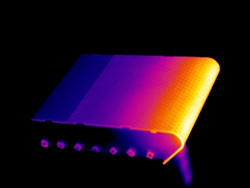Thermal protection systems can take the heat
Thermal control systems consist of materials designed to maintain all vehicle components within tolerable temperature limits during the many mission phases. Despite changing heat loads and thermal environments, all these systems use high-emissivity materials or coatings to ensure the maximum rejection of incoming heat. The EU-funded project THOR(opens in new window) (Innovative thermal management concepts for thermal protection of future space vehicles) was launched to advance new thermal control concepts. Specifically, four new concepts will be verified by extensive testing under realistic atmospheric entry conditions. Two concepts are based on minimising thermal gradients by transferring heat efficiently from highly loaded surfaces to less loaded components of the spacecraft. By using new ceramic matrix composite (CMC) materials with integrated conductive carbon fibres, THOR partners work on maximising heat exchange through heat conduction and radiation. Active cooling is the key feature of the other two THOR concepts. These thermal control systems will combine multiple methods for heat protection, including transpiration cooling of external spacecraft surfaces and convective cooling based on a sandwiched structure composed of a CMC skin and a core made of ceramic foam. For each concept, models are being designed and manufactured to be tested in the THOR partners' arc heated and wind tunnel facilities in Germany and Japan. A technology readiness level higher than two is expected to be achieved for the new thermal control concepts by the end of the project. The THOR project will help maintain Europe's leadership in thermal protection by significantly improving aerodynamic performance and flight path control for re-entry into Earth's atmosphere from orbital flight . The same technologies would be beneficial for hypersonic transport vehicles, in particular when launched by rocket propulsion.







